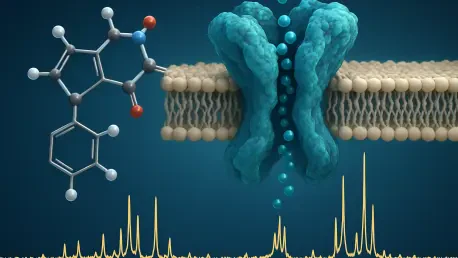Picture a world where millions suffering from depression, heart disease, or cancer could access faster, more effective treatments, all thanks to a microscopic discovery that is changing the landscape of medicine. At the heart of human cells lie ion channels—tiny proteins acting as gatekeepers, controlling the flow of ions vital for nerve signals, muscle movements, and immune responses. When these channels malfunction, the consequences can be devastating, contributing to a staggering array of diseases. Yet, for decades, designing drugs to target them has been an uphill battle, hindered by the sheer complexity of studying their behavior. Now, a cutting-edge technique using nuclear magnetic resonance (NMR) spectroscopy offers a glimpse into these cellular gateways like never before, promising to transform the landscape of medical innovation.
Why This Matters: The Urgent Gap in Drug Development
Ion channels are implicated in conditions affecting billions worldwide, from neurological disorders to cardiovascular ailments. Despite their critical role, progress in developing targeted therapies has been frustratingly slow, often taking years and costing billions due to the challenge of observing these proteins in their natural state. Traditional methods require isolating ion channels from cells, a process that distorts their behavior and yields unreliable data. With patient needs mounting—over 264 million people globally battling depression alone, according to World Health Organization estimates—the demand for a breakthrough has never been more pressing. This NMR-based method steps in as a potential game-changer, offering a faster, more accurate path to creating life-saving medications.
Peering into Cells: How NMR Redefines Drug Research
At the core of this innovation is a technique that allows scientists to study ion channel-drug interactions directly within living cells, a feat previously thought nearly impossible. Developed by an international team spanning institutions in Spain and the UK, this method leverages NMR spectroscopy to capture real-time data without the need to extract proteins from their cellular environment. The result is a clearer, more biologically relevant picture of how drugs bind to these channels, cutting through the distortions of older approaches. Experiments that once dragged on for days or weeks now conclude in under an hour, slashing both time and financial costs.
Beyond speed, the technique’s precision stands out as revolutionary. By focusing on specific ion channels like P2X7 receptors—linked to depression and certain cancers—researchers have mapped exact interaction sites between drugs and proteins. This level of detail acts as a blueprint for designing medications that are not only more effective but also less likely to cause side effects due to off-target interactions. Such advancements signal a shift toward smarter, more tailored therapeutic solutions.
Voices of Discovery: Experts Weigh In
The excitement surrounding this breakthrough resonates deeply within the scientific community. Jesús Angulo from the Institute of Chemical Research in Spain describes the leap in accuracy as transformative, noting, “Observing drug behavior directly in living cells gives us a truer understanding of their impact, something we’ve long needed.” Leanne Stokes at the University of East Anglia echoes this optimism, pointing to the potential for accelerated drug pipelines that could reach patients sooner. Meanwhile, Serena Monaco of the Quadram Institute highlights the method’s ability to pinpoint binding sites with unprecedented clarity, a crucial step for crafting precise treatments. Published in the Journal of the American Chemical Society and backed by funding from bodies like the UK’s Biotechnology and Biological Sciences Research Council, their collective insights underscore a shared belief in the technique’s power to reshape pharmacology.
The real-world implications are already sparking interest beyond academic circles. Pharmaceutical companies are taking note, recognizing that this tool could streamline early-stage drug screening and reduce the high failure rates often seen in clinical trials. With such endorsements, the method’s credibility is cemented, paving the way for broader adoption across research and industry alike.
A Roadmap for Impact: Implementing the Technique
For labs and drug developers eager to tap into this NMR approach, the practical steps are both straightforward and promising. The process begins with integrating the method into initial drug screening phases, focusing on ion channels tied to high-priority conditions such as epilepsy or hypertension. By observing interactions in real time within living cells, teams can quickly identify promising compounds without the cumbersome prep work of traditional studies. This efficiency allows for testing a wider array of potential drugs in less time.
Pairing these experimental insights with computational tools adds another layer of potential. Bioinformatics software can generate 3D models of drug-receptor interactions, validated against NMR data, to refine drug designs for maximum efficacy. Researchers are encouraged to target diverse ion channels, using the cost savings to explore conditions once considered too complex to tackle. This structured framework not only makes the technique accessible but also positions it as a catalyst for uncovering therapies that address unmet medical needs.
Building on a Milestone: The Path Ahead
Reflecting on this journey, the strides made with the NMR-based technique stand as a testament to global collaboration and innovative thinking. Scientists have bridged a critical gap, moving from distorted lab models to real cellular insights, setting a new benchmark for drug design. The focus on P2X7 receptors has proven the method’s worth, opening doors to treatments for mental health and oncology challenges. Looking back, the integration of experimental data with computational modeling has emerged as a defining strength, offering a glimpse of precision medicine’s potential.
Moving forward, the priority shifts to scaling this approach, ensuring labs worldwide can access the necessary equipment and training. Efforts need to center on expanding research to other ion channel types, potentially unlocking solutions for even rarer diseases. Partnerships between academia and industry are seen as vital to translate these findings into therapies on pharmacy shelves. Ultimately, the challenge is clear: sustain this momentum, refining the technique further to ensure that the promise of faster, better drugs becomes a reality for patients everywhere.









